Organizational Change Management Strategies
Introduction:
Change management can be referred as the process under which an organization brings about effective changes in its organizational structure, function and culture to improve organizational productivity and increase organisational efficiency in terms of achieving the short time and long terms common organisational goals (Archibong and Ibrahim, 2021). In this modern competitive business world, any business does not stay stagnant, rather businesses go through the continuous transformation for seizing new opportunities in the external market in terms of improving their competitive advantage. This essay will discuss the organizational transformation or change management of the company Quiltco in terms of dealing with the current challenges that it is facing regarding meeting the harsh deadline of its new order of Kokuna sweaters. In this context, this essay will use the Theory of Change [TOC] for demonstrating how the company in the given case study will use the three important processes such as planning, implementation and evaluation of change to improve its overall organizational structure and operation process to increase its overall organisational efficiency in meeting the organisational target. Here this essay will use discuss Lewin Change Management Theory for discussing the step-by-step process of the change or organizational transformation of Quilto. By applying TOC this case study essay will discuss how the proposed changes can be implemented into the work process of Quiltco to improve its overall organizational productivity and operational process and solve all the issues that its face regarding its new order. Here the essay will also discuss the SWOT and STEEPLE analysis for Quilco for evaluating the need for changes and the key drivers that this company needs to consider to implement effective changes in the organization. Then this essay will demonstrate the perspectives and roles of each stakeholder of this company in the pre and post-change condition to analyses stakeholders' roles in supporting this company to go through an effective organizational transformation to improve overall organizational productivity and brand image in the international market. Finally, this essay will demonstrate a conclusion in which the key aspects of the entire discussion will be summarized. the essay will present a learnt lesion in which the aspects that have been learnt in personal and organisational contexts will be discussed.

Organisational background and need for change:
Company background:
Quiltco is a textile manufacturer in the West Midlands, UK. It is famous for its exclusive design and fabric. It manufactures a wide range of men and women attire by considering current fashion trends and customer buying behaviours. This company is famous for its innovative clothing designs that are designed by modern and highly trained designers. Currently, this company work on two big orders one from Kokuna, the Japanese golf equipment manufacturer and the other is from P&D.
STEEPLE analysis for Quiltco:
STEEPLE analysis is an important strategic analysis tool that will assist organizational leaders of Quilco to evaluate the impact of the external market factors (social, technological, environmental, economic, political-legal and ethnic actors) on the overall management process and business operation of this company thereby enabling the organisational leaders to determine what changes need to be done in the organisational structure and function to meet the current organisational goals (Bennett and Soylu, 2021). This STEEPLE analysis will enable the organisational leaders of this company to determine what changes need to be done in this organisation and how these changes can be implemented into the organisational framework to improve the overall productivity and competitive advantages of this company.
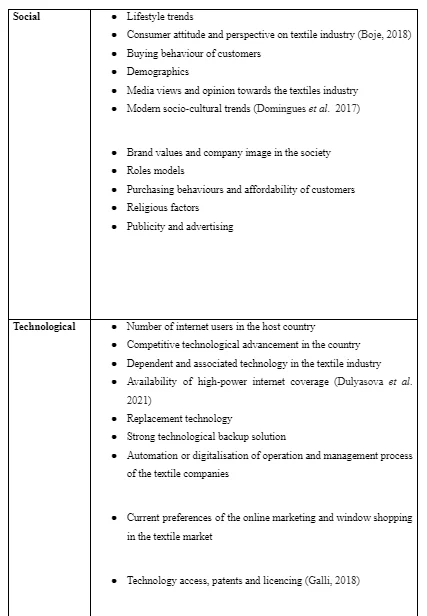
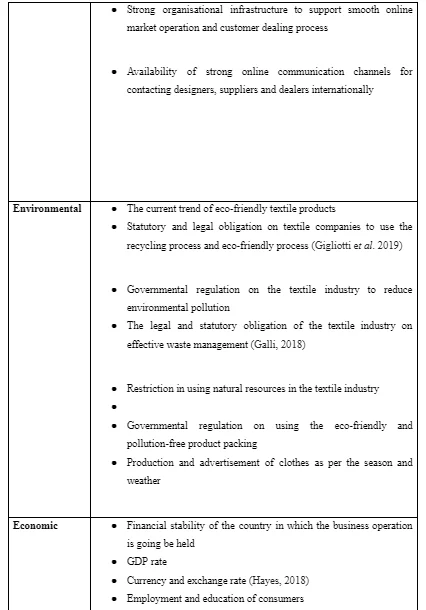
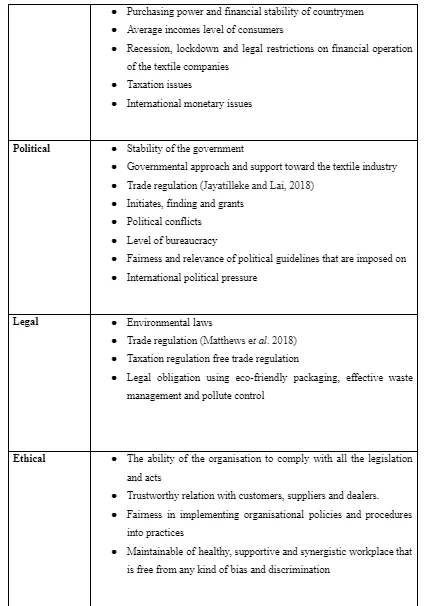

Explanation of the need for change based on the above-mentioned STEEPLE analysis:
By analysing the above-mentioned external factors, the managers or organisational leaders of Quiltco can identify the areas of changes in the organisational structure and functions. Society is the important factor that needs to be considered by the managers of Quiltco while going to work on the order for Kokuna sweaters. Here managers need to analyse the current socio-cultural trend in the clothing and textiles market in Japan. As started by McCarthy et al. (2021) while it comes to going effective change management in terms of operating business in a foreign market, the marketers need to conduct thorough research on the social and cultural trends and customer behaviour in the host country and what particular changes need to be implemented into the production and operation process to meet customers’ demand. Here the marketers of Quiltco need to analyse the current fashion trend and fashion preferences regarding winter wear in the Japanese market. Technology is another most important factor that managers in Quiltco need to consider to implement effective organisational transformation to meet the deadline of manufacturing Kokuna sweaters. Here organisational leaders of Quiltco need to evaluate the technological advancement, numbers of internet users, the tendency of online shopping in customers and availability of internet connection in Japan (McGuinness and Abbott, 2020). As Japan is technologically advanced with a high number of internet users, Quiltco needs to focus on bringing about effective changes in its technological framework to improve overall online martlet channels. The economic factor is also an important key factor that organisational leaders must consider while working in both domestic and foreign markets (Mirkamali et al. 2017). Here the organisational leaders of Quiltco must consider the economic stability, GDP growth, purchasing power of consumers and the average incomes level of customers. The analysing of impacts of the economic factors will enable this company to make necessary changes in the budget management system thereby reducing the additional operation, production and management cost thereby maintaining a cost-effective system. Environmental factors are also essential for Quiltco to check what changes are necessary to cope up with the possible impacts that environmental factors have on its current business operation. Here the managers need to evaluate how the statutory guidelines and legal obligations on eco-friendly production, waste management and recycling can impact the production and operation cost of Quiltco (Qureshi et al. 2021). Political and legal factors have a potential impact on the operation and business management of any company while it comes to operate the business in the international market. In the case study, organisational leaders of Quiltco need to consider legislative guidelines and the political framework of both Japan and the UK in terms of operating a smooth business operation (Schmidt et al. 2017). In this context, the marketers of Quiltco needs to consider the political stability, level of bureaucracy and fairness in the regulation of the textile industry in the two countries (Rosenbaum et al. 2018). Additionally, the managers of Quiltco need to evaluate the impacts of different; legislation in the UK and Japan on textiles industry such as trade regulation free trade agreement, taxation law, wage law, labour law and environment laws. By conducting this political analysis, organisational leaders would be able to determine which changes need to be brought about in the organisational framework to deal with all the political impacts thereby maintaining smooth and fast production and manufacturing process to meet the deadline of the order. Ethical factors also have potential impacts on the overall brand image and the organisational reputation of any company. In the given case study, all the organisational leaders of Quiltco needs to ensure that the change management process will improve the compatibility of this organisation to comply with all the legislative and statutory guidelines regarding its business operation (Rudnev, 2020). Additionality organisation leaders will also improve the organisational framework in which they will be able to maintain a trustworthy and transparent relationship with their clients, customers and community. Apart from the financial profits, the organisational leaders must ensure the community welfare throughout the business which will assist this company to improve its brand image in front of the international marketers and customers.
Description of the change process:
While it comes to bring about effects d high relevant transformation in an organisational operation, organisational leaders need to follow a highly appropriate model of change management (Stouten et al. 2018). Here the managers of Quiltco in the given case study is going to follow those three stages of theory of change (TOC) such as the planning, implementation and evaluation stage. In the planning stage, managers of Quiltco will set a plan in determining or identifying the changes needed to bring about in the organisational structure n operation to achieve their current objectives (Van der Voet and Vermeeren, 2017). In the implementation stage, the managers will be using effective strategies to implement these changes or transformations in the organisation to fulfil its target (Archibong and Ibrahim, 2021) In the evaluation stage, managers will analyse the usefulness of these changes that are implemented into the organisational framework to meet the organisational objectives.
Planning:
This is the first stage of TOC that any business needs to follow while going for conducting effective change management in the organisational framework (Bennett and Soylu, 2021). This is about developing a plan for setting organisational objectives the need to be achieved through bringing about effective and correct changes in the organisational framework. Organisational leaders of Quiltco would perform the following activities in this planning stage:
Identification of needed changes:
The first and most important process that organisational leaders need to follow while going for effective organisation transformation is the identification or determination of the proposed changes (Boje, 2018). In the given case study, the needed changes that are to be implemented in the imaginational framework are: Transforming the current organisational leadership and management framework into a more effective and relevant process (Domingues et al. 2017) Improve the overall operation and production management process to enhance the organisational productivity and competitive advantages of Quiltco in the external market (Dulyasova et al. 2021) Effective transformation of technological infrastructure io Quiltco in terms of enabling this company to meet the deadline of its recent order and also compete with potential marketers of international market
Objectives under this proposed organisational change:
Through implementing these above-mentioned changes or organisational transformation his company (Quiltco) aims to achieve the flowing objectives:
To improve the organisation productivity and the individual productivity of each staff of Quiltco (Galli, 2018) To offer exclusive quality and design of the Kokuna sweaters to the client company that can meet the expectation and demand of Japanese customers (Gigliotti et al. 2019) To improve the sustainability and the strength of the internal organisational resources thereby improving the competitive advantages of Quiltco in the external market To enhance and improve brand images da brand reputation of Quiltco in the international textiles market To enhance the product and service optimisation by improving the overall production and management process that enables the company to fulfil any kind of customer’s demand and expectation (Hayes, 2018). To enhance the overall professional standard and work process and the performance standard each staff thereby improving their overall productivity which will enable the company to deal with any kind market challenge in the international textiles market
Resources planning under the organisational change:
5 M of management:
Following resources are going to be planned for implementing the abovementioned changes in the organisational framework of Quiltco.
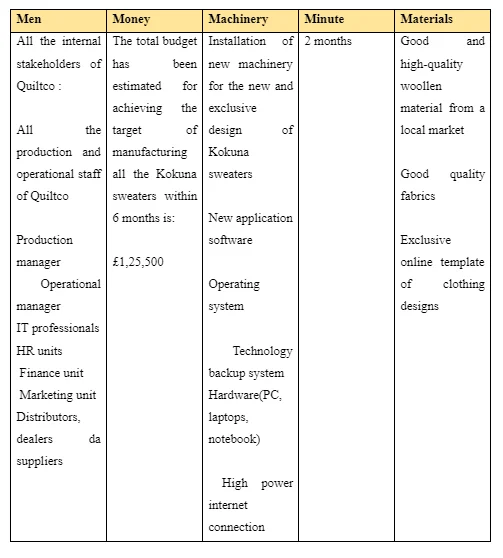
Budgetary planning:
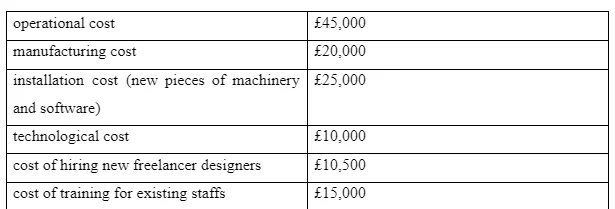

Implementation:
This is the second stage of the TOC, in hic organisational leaders implement the proposed changes into the organotitanium framework by applying effective and highly relevant strategies. in this given case study, the organisational leaders of Quiltco are going to implement the flowing strategies in terms of implementing the above-mentioned changes into the organisational framework.
Change management strategies:
Leadership change:
As mentioned by Hayes (2018), while it comes to conduct effective changes management in any organisation organisational leaders must focus on replacing the existing leadership and management process with the new and highly relevant processes. In the case of Quiltco, the organisational leaders can better use a democratic and transformational leadership process. As there is the severe conflict between the managers and manufacturing staff in Quiltco regarding working on the new order of Kokuna sweaters, transformation and democratic leadership can assist this organisation to develop such a leadership and management styles that will motivate the staff to work in collaboration with new designers and maintain proper synergy in the work process. As mentioned by Jayatilleke and Lai (2018), transformation leadership is highly effective in the modern business world, in which managers can involve all the subordinate staffs in the shared decision making for the organisational gaols setting, objectives and planning. On the other hand, democratic leadership also enables the managers of Quiltco to work in collaboration with all the staff by allowing them to present their valuable opinion and decision regarding meeting the biggest order of Kokuna sweaters in this short deadline.
Redefining cultural values;
Under this strategy of change management, the organisational leaders of Quiltco will redefine the cultural and moral values of this company. Under this initiative, employees will be motivated to follow the ‘fit in’ and go along’ cultural norms of this organisation. As mentioned by Matthews et al. (2018), change management through redefining the organisational cultural values in front of employees is a highly effective process in which employees are motivated and inspired to maintain collaboratives, synergist relations with the colleagues and managers and work on common organisational goals instead of on prioritising their individual goal. This strategy is expected to be highly useful for Quiltco to motivate and convince the designers and manufacturing staff to work in collaboration with the newly hired designers to fulfil the target of Kokuna sweaters before the given deadline.
Improving communication:
Effective and well-organised communication is crucial for any organization to improve its overall operation and management process thereby implementing effective transformation within the organisational framework (McCarthy et al. 2021). In the case of Quiltco, it needs a well-organised and effective communication system the will enables all the units of this company to get valuable information regarding the order at right time. In this context, the IT unit of Quiltco must develop and implement an effective online communication portal for all the organisational departments which are working on this order of Kokuna sweaters. Under this online communication channel, the managers of different unite such as production, finance, IT, Human Resources and operation, can connect to the designers manufacturing staffs at any ties thereby can track their work progress on this order.
Promoting employee engagement and employee motivation:
Promoting employee engagement is a highly effective strategy in implementing effective transformation in the operational and management process of an organisation to achieve maximum productivity (McGuinness and Abbott, 2020). In the given case study, Quiltco needs to implement an effective employee engagement strategy to improve the manger- staffs relation by redeeming the trust, faith and respect between them. Here the managers need to motivate the designers and other production and manufacturing staff why are offended by the decision taken by the company for hiring a new freelancer designer. In this context, this company can use different employee engagement strategies such as salary hikes, incentives, positives and supportive work environment, financial reward to the achiever of the task, promotion and annual appraisal ((Mirkamali et al. 2017).
Evaluation:
This stage of TOC is associated with checking the usefulness of change management strategies in meeting organisational goals (Qureshi et al. 2021). Production managers of Quiltco can use the relevant and effective evaluation process that can enable them to evaluate whether all the above-mentioned change management strategies are useful in bringing about the proposed changes in the organisational framework. These evaluation processes are as follows: Reviews from the managers and all the staff of production and manufacturing units would be highly effective in terms of collecting valuable feedback from all these professionals regarding the effectiveness of the implemented change management strategies (Rudnev, 2020). Here managers can analyse the feedback from the existing designees and newly hired designers and other production staffs on whether the above-mentioned cage management strategies are worthy to improve organisational productivity as well as individual productivity of each staff to fulfil the order from Kokuna. By tracking the ongoing progress of the company’s order, the organisational leaders of Quiltco can understand the strength and areas of improvement of the above-mentioned changes management strategies (Stouten et al. 2018). In this context, managers can track the performance level, work process, operational process and product optimisation process of Quiltco in terms of checking whether these change management strategies are effective in assisting the production staffs to manufacture and design the Kokuna sweaters within the given deadlines/. By conducting the Quality Check Program, organisational leaders of Quiltco can check whether the designers and the production staffs are able to produce the exclusively designed and high-quality Kokuna sweaters that would surely meet the expectation of the client. In this Quality Check process, production managers will check and analyse whether the design and quality of the Kokuna sweaters will match the criteria of the client company and can also evaluate the additional changes or modifications that need to be implemented in the production and operation process to achieve the target.
Perspectives and roles of the key functional areas:
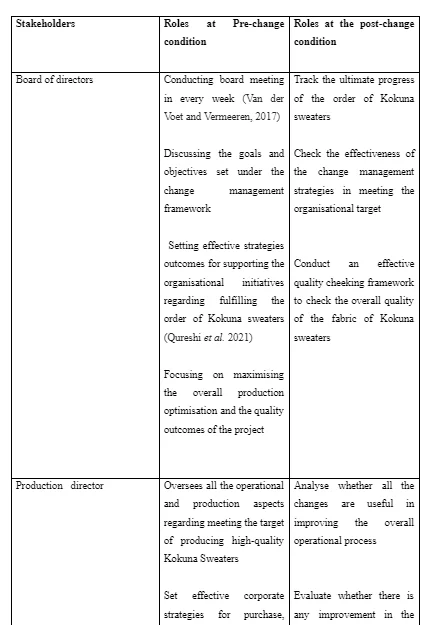
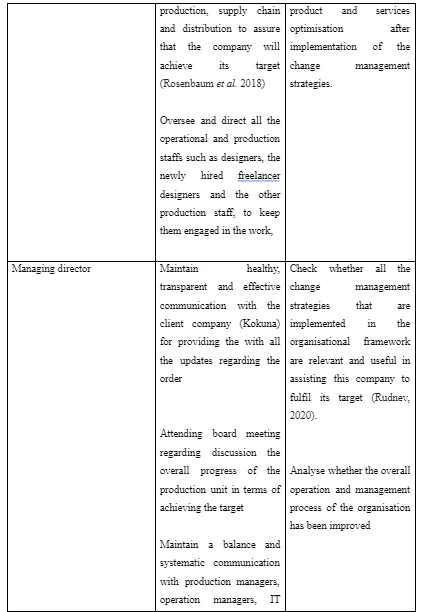

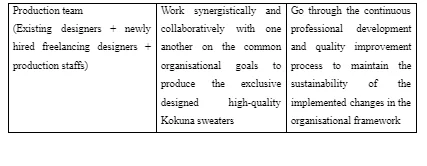
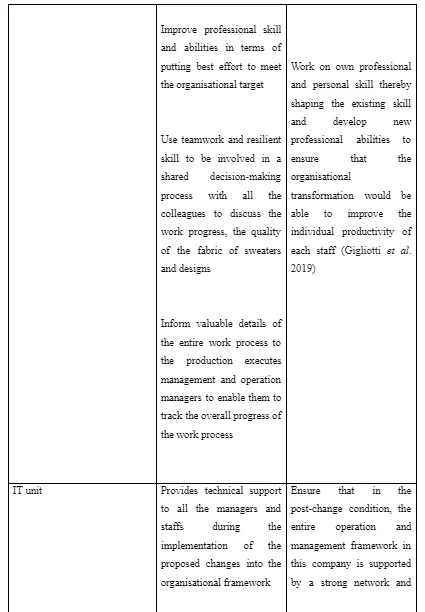
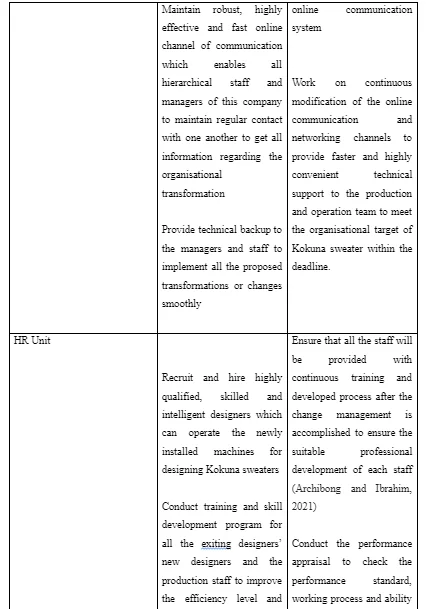
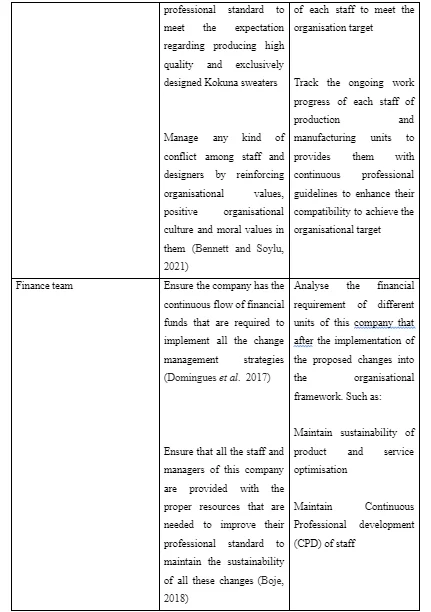
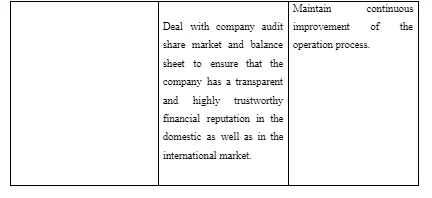
Key theories:
Three important theories of change management can be applied by the organisational leaders of Quiltco to bring about effective transformation in the overall operation and management process to enable this company to be enough compatible to achieve a target.
Lewin’s Change management Model:
This theory had been introduced by Kurt Lewin who present three major stages of change management that every organisation needs to follow to conduct proper planning, implementation and evaluation of the proposed organisational changes or transformation. These stages are, unfreeze, transition and freeze (Dulyasova et al. 2021).
Unfreeze:
This is the first and most important stage of change management, in which the organisational leaders of Quiltco will determine and plan the changes or transformations that need to be done in this organisational framework to improve the organisational efficiency in meeting its target (Galli, 2018). Now the current target or objectives of this company is to complete the order of Kokuna sweaters within the gyve deadline by eliminating all the associated barriers and challenges such as employee conflict, the lack of new machinery for design Kokuna sweaters and lack of skilled designers. In this context, organisational officials of Quiltco will:
Recognise changes that are needed to be implemented in the operation management and production process of this company (Gigliotti et al. 2019) Plan and arrange the required resources for implementing these changes such as proper training program for designers and production staffs, installation of the new designing machine and financial support, technical backup Set effective change management strategies that need to be implemented to achieve the organisational target (Galli, 2018) Motivate old and existing designers and production staff to shape and improve their professional skills as per the current goals and target of the organisation. in this context conduct employee engagement, professional development program and tracking of work progress of each staff.
Ensure that the company has the organisational infrastructure that can provide the necessary time to ties management operational, and financial support to the entire production team to fulfil the order of Kokuna sweater asap.
Transition:
This stage is about the implementation of all the proposed changes into the organisational framework to enhance organisational productivity and efficiency to meet its proposed goals (Hayes, 2018). Organisational leaders of Quiltco will implement all the change management strategies that are planned in the unfreezing stage. In this stage;
An effective and fast communication system will be developed which enables the managers and staff of the production unit to discuss the work progress, needed resources and any kind of risk (Jayatilleke and Lai, 2018)
employee motivation and employee engagement stagey will be implemented in which the existing production staff and designers will be provided with incentives, financial rewards, salary hikes and promotion based on their performance in meeting organisational targets (Matthews et al. 2018)
A continuous professional development training will be conducted under which all the existing designers and production staff will be trained on how they can use the modern designs and fabric in clothing to make these clothes more attractive and demanding in the international market
Refreeze:
This stage is to ensure the substantiality of all changes or transformations that are implemented into the organisational framework. In this stage. The organisation leaders of Quiltco will ensure that:
All the changes that are implemented into the organisational framework are stabilised and well-sustained (McGuinness and Abbott, 2020)
Continuous quality check processes will be conducted for improving the outcomes of organisational changes.
All the staff will go through continuous professional development (CPD) which will shaper the existing skill and develop new skills in terms of implementing all the organisational changes in the right ways to maximise the organisational productivity (Mirkamali et al. 2017).
Conclusion:
From the above-mentioned discussion, it can be concluded that change management is highly important for any modern business which enables organisational leaders to bring about changes in the organisational framework to maximise organisational productivity and improve its efficiency in meeting short terms and long-term goals. Change management is associated with the Theory of Change (TOC) which will assist organisational leaders to follow three steps such as planning, implementation and evaluation, for conducting an effective change management process. Lewin’s change management made is a widely used model that organisational leaders can use for making effective transformations in the organisational operation and management process to achieve organisational targets. Lewin's model has three stages such as unfreeze, transition and refreeze. Following all these changes organisational leaders can achieve the organisational target by implementing the necessary transformation in the management, operation and financial process.

Lesson learnt: ( personal and organisational)
This project assisted me to conduct an effective personal development under which I am able to shape my existing personal skill and developed innovative new skill. Throughout working on this project, I am able to develop good communication and interactive skill. I have learnt the importance of transparent and effective communication in the professional field in terms of sharing all the valuable information regarding the organisational goals, objectives and work progress. This project also enables me to develop strong analysing and critical thinking skills. Throughout working on this project, I am able to understand how to analyse each issue or aspect of professional and personal life critically to evaluate the root cause of the issue and develop the correct strategies to overcome the issues or challenges. I also developed effective time management skills which will enable me to complete each task within the proper deadlines by meeting all the task criteria. In the organisational context, I have learnt about all the aspects of change management this project assisted me to develop a good understanding of what change management is and how it impacts the organisational productivity efficiency and operational optimisation n of a company. I have learnt about different theories of change management such as Lewin’s change management theory model, Kotter’s change management model and Theory of Change (TOC). I have developed a clear concept on the application of all these change management theories into the organisational context to bring about effective organisational transformation to meet the organisational target. I also develop a clear conceptualisation on risk assessment and crisis management associated with change management.
Reference list:
Archibong, U. and Ibrahim, U.A., 2021. Assessing the impact of change management on employee performance: Evidence from Nile University of Nigeria. International Journal of Research in Business and Social Science (2147-4478), 10(4), pp.525-534.
Boje, D.M., 2018. The Contributions of Savall's Socioeconomic Double Spiral and Multiplicity to Change Management. In 7ème Colloque et séminaire doctoral-7 et 8 juin 2018-Lyon, France-ISEOR, Academy of Management (ODC).
Domingues, A.R., Lozano, R., Ceulemans, K. and Ramos, T.B., 2017. Sustainability reporting in public sector organisations: Exploring the relation between the reporting process and organisational change management for sustainability. Journal of environmental management, 192, pp.292-301.
Dzwigol, H., Shcherbak, S., Semikina, M., Vinichenko, O. and Vasiuta, V., 2019. Formation of Strategic Change Management System at an Enterprise. Academy of Strategic Management Journal, 18, pp.1-8.
Gigliotti, R., Vardaman, J., Marshall, D.R. and Gonzalez, K., 2019. The role of perceived organizational support in individual change readiness. Journal of Change Management, 19(2), pp.86-100.
Jayatilleke, S. and Lai, R., 2018. A systematic review of requirements change management. Information and Software Technology, 93, pp.163-185.
Matthews, J., Love, P.E., Mewburn, J., Stobaus, C. and Ramanayaka, C., 2018. Building information modelling in construction: insights from collaboration and change management perspectives. Production planning & control, 29(3), pp.202-216.
McGuinness, S.J. and Abbott, L., 2020. Change management in Northern Ireland’s transformed integrated schools:: What we want is a school where you can be who you are and it’sa safe place. International Journal of Inclusive Education, pp.1-16.
Qureshi, S., Khan, S.U.R. and Iqbal, J., 2021. A Study on Mitigating the Communication and Coordination Challenges During Requirements Change Management in Global Software Development. IEEE Access, 9, pp.88217-88242.
Schmidt, E., Groeneveld, S. and Van de Walle, S., 2017. A change management perspective on public sector cutback management: towards a framework for analysis. Public Management Review, 19(10), pp.1538-1555.
Stouten, J., Rousseau, D.M. and De Cremer, D., 2018. Successful organizational change: Integrating the management practice and scholarly literatures. Academy of Management Annals, 12(2), pp.752-788.
Van der Voet, J. and Vermeeren, B., 2017. Change management in hard times: Can change management mitigate the negative relationship between cutbacks and the organizational commitment and work engagement of public sector employees?. The American Review of Public Administration, 47(2), pp.230-252.
- 24/7 Customer Support
- 100% Customer Satisfaction
- No Privacy Violation
- Quick Services
- Subject Experts



